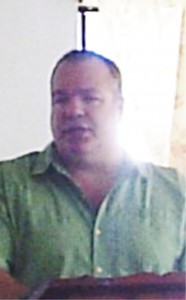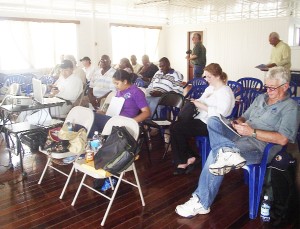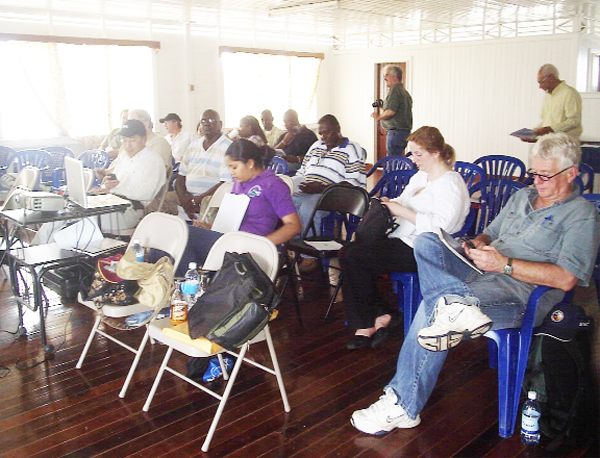-250,000 to 350,000 ozs per annum targeted
The spectre of the Omai gold mines spill, concerns about river water, and other issues were among the “significant” raised when a public scoping meeting on the proposed Guyana Goldfields Inc large-scale Cuyuni gold mine, was held at Bartica on Wednesday.

Meantime, President of the company, Claude Lemasson disclosed that they plan to produce between 250,000 to 350,000 ounces of gold per year. Guyana Goldfields is planning to establish a large-scale gold mine at Aurora, Cuyuni River and the meeting was part of the process towards the undertaking of an Environmental Impact Assessment (EIA), which will determine whether the Environmental Protection Agency (EPA) grants approval to the project.
Apart from company representatives and EPA personnel, just over 20 persons attended the meeting in the New Modern Hotel conference room, which is required to be held under the law. While a few persons raised issues of concern to them others spoke up in favour of the investment.
A project summary of the proposed mine states that the development and operation of the mine site will involve construction and operation of the mine site, construction and operation of a hydropower plant on the Cuyuni River, construction of an access road to the mine site, and construction and operation of a wharf at Buck Hall on the Essequibo River.
In giving an overview of the venture at the meeting, Lemasson said that construction could start by early next year and the hydro-power plant “is an option that we are currently considering”. Observers note that such a plant would raise significant environmental issues. Lemasson stated that MWH (Montgomery Watson Harza of Argentina) is designing the facility and it will include two turbines with an option to add more.
He said that the design should be completed by the end of this year. Mining, he said, will be executed in two components with two to three open pits and open pit mining will be done for “the first five years or so” while a shaft for underground mining is being developed. He said that the shaft could potentially be put in after the second year of mining and would take three years to develop.
The company’s president noted that along a section of the Cuyuni, there is a low-lying area that is susceptible to flooding and the company plans to build a dyke to protect the open-pit areas from flooding. He said that there is a temporary airstrip at the site but they plan on installing an 1100-metres permanent airstrip.

According to Lemasson, while there will be an expatriate component, the company plans to maximize the use of Guyanese personnel and will also provide training. He declared that the company will also do some work in collaboration with universities. He said that they plan to move 10,000 tonnes (of ore) per day and are looking at 250,000 to 350,000 ounces (of gold) per year of production.
Meantime, a few persons who were present voiced their concerns. One Bartica resident raised the issue of the Omai tailings dam collapse in 1995 and said that he hoped that the company would do as much as possible to prevent cyanide from escaping so that “Omai would not happen again”. He also declared that people living along the river depend on it for water and stating that the water quality will change asked about water purification for the area.
Another speaker said that Amerindians would be displaced and based on the set-up of the mining sites, the water would get discoloured. He said that fish would be affected, declaring that Amerindians depend on the waterway to catch fish. He questioned what would the benefits be for Amerindians and asked what the company intends to do with “the huge forest that will go to waste”.
However, another speaker, who said that he was a miner operating in the Cuyuni River, stated that the investment is the best development for the community and the country. He stated that in the Cuyuni, water is very important for mining and the first thing he focuses on is a well for workers.
He said that Amerindians would be happy for jobs. “The main thing right now is to have development and opportunities”, he declared asserting that Amerindians surviving on fishing and hunting would welcome jobs. But, another speaker pointed out that the only established Amerindian community is far upstream from the mine. He declared that there is no community downstream and stated that the Cuyuni water is contaminated already. According to him, there is nothing to affect the Amerindians in the area.
A few other issues were raised by an earlier speaker including what the company would do for some groups that are marginalized, how the company plans to respond in the event of a “major infection” coming out and afflicting the community, what other economic benefits there would be apart from jobs and whether tolls would be charged on roads, among others.
Shawn Hopkinson, a miner said that he welcomes the venture stating that the water in the Cuyuni is not “usable for consumption”. He stated that there are no Amerindian villages within the site area and some issues raised were not “wholesome” for the meeting.
He declared that the persons had no knowledge of the site and everyone would benefit from the venture. He said that Amerindians are “still in the wilderness” and they would depend on miners for services such as medicine. He added that no government official ever goes to those areas.
Charles Ceres, the EIA Consultant and team leader said that there are three primary elements of the assessment. He identified some of the potential environmental impacts as changes in water quality, impact on air quality, silt deposits in the river, alteration in the aesthetics of the site, increased soil erosion, impacts to the landscape and some alteration in ground-water flow regimes. Potential biological impacts include development of aquatic life, floating clumps of vegetation, loss of land, land-based communities affected by flooding (those close to the hydro-power dam), increase in nutrient levels, impacts on fish and impacts to the eco-systems and the food chain with the movement of animals away from the site.
Potential social impacts include increased economic activities, an increase in water-borne diseases, increased access to the site, increase in the cost of living and some marginalization of minority groups due to the lack of resources.
Chairperson of the meeting, Hance Thompson said that the issues raised are significant and will be examined by the EIA.
The project summary says that ore recovery will consist of a combination of open pit and underground mining and the combined schedule will result in a mine life of approximately 12 years. Power for the process plant operation and ancillary services, according to the summary, will be provided by a run-of-the-river pondage hydropower plant to be constructed on the Cuyuni River, 8km away from the mine site. According to the Guyana Goldfield’s website, a 10-15 megawatt hydroelectric facility is envisioned and two pre-feasibility studies done found that the optimum site both technically and economically is the Julian Ross Itabu River location, where the installed capacity is calculated to be 11MW.
The project summary says that a road will be constructed from the mine site to access the power plant location and the hydropower facility will entail construction of a dam across Julian Ross Itabu. The proposed facility will be located in the left branch of the Cuyuni, 8km upstream of the proposed mine site, in an area where the Cuyuni River divides into Devil’s Hole and Julian Ross Itabu on the left and right respectively. It will be located on the Julian Ross Itabu branch of the river, which is the smaller of the two branches that join downstream to form the Cuyuni River and which carries 35% of the total flow of the Cuyuni River at this point. The facility will consist of an earth-fill dam, a spill way, bottom outlets for the reservoir and the power station.
The company has already done some preliminary construction at the mining site including the building of a camp and it has also built a 2000-feet airstrip at the Aurora location. Guyana Goldfields Inc is a Canada-based mineral exploration company primarily focused on the exploration and development of gold deposits in Guyana, where it has operated since 1996.

